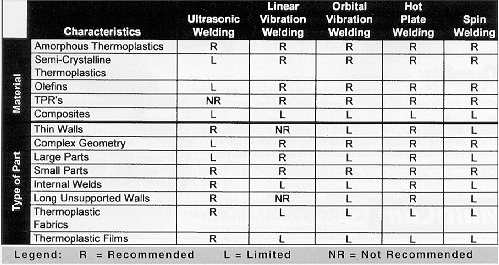|

WELDING USING ULTRASONIC, HOTPLATE, VIBRATION AND SPIN WELDING
Assemblers of plastic products have a variety of joining options to consider, such as adhesives and "bridge" methods such as staples, clips, or screws. Consumables, however, can be costly, in addition to increasing your production time and creating environmental and recycling issues.
If you are concerned with the cost of consumables, interested in "green" manufacturing, and are possibly hoping to increase your production rates, you may want to consider joining processes that use the plastic itself as the bonding agent - ultrasonic welding, hot plate welding, spin welding, and vibration welding. This article will briefly outline each process and show you how to determine which is the right technique for your application.
The following questions will help narrow your choice:
1.What type of polymer are you using? Some polymers are suitable to some assembly processes and not to others, and factors such as pigments, percentage of regrind, etc. can affect the final result.
2. Does your part have internal walls or ribs? Are the parts small or large? Does the part have a complex geometry? Are you welding one part at a time, or several? Again, the process you choose depends on the part size and geometry of the piece, and the number of parts you are processing at a time.
3. How strong does your final bond need to be? If your product is a toy or a tool, your weld will need to be stronger than that of a disposable package.
4. Is a hermetic seal required? Hermetic seals are crucial on parts such as pumps and filters, and this needs to be considered as well.
5. Does the assembly require a flash-and particulate-free appearance? A weld on the outside of a pager would need to appear "cleaner" than the weld on the inside of a dashboard, although they may be identical in strength. Additionally, welds used on applications such as medical devices and food containers should not contain any visible material overflow in the weld area (known as flash) which could break off and contaminate the contents.
Which process is which?
Ultrasonics
n Ultrasonic energy is mechanical vibratory energy operating at frequencies beyond audible sound, usually 20 or 40 kHz. The energy transmits into the material for joining through an acoustic tool known as a horn. Thermal energy is released, causing softening and melting to occur at points of limited contact.
n Used for assembling products that require either structural or hermetic seals, such as toys, ink cartridges, and floppy disks.
Hot Plate Welding
n The hot plate welding process employs a temperature-controlled heat platen assembly, which is introduced between the two parts to be assembled. The parts are melted for a pre-set time to displace enough plastic for surface preparation and to properly heat the substrate at the joint plane. The parts are separated, the heat platen withdrawn, and the mating parts brought together to form the final assembly.
n Ideal for producing high-pressure, hermetic seals, and for applications that employ curved joints, internal walls, thin walls, and/or complex geometries, such as automotive dashboards, pumps, automotive and small appliance fuel tanks and fluid reservoirs, pallets, and washing machine balance rings.
Vibration Welding
There are two types of vibration welding: linear and orbital:
n Linear vibration welding utilizes an electro-magnetic drive to create relative motion between two thermoplastic parts. This reciprocating motion generates heat, which raises the material temperature at the joint to its melting point. The motion is stopped after sufficient material is melted. The plastic then solidifies and forms a permanent bond. Each point on the driven joint surface traces a straight line on the stationary joint surface.
- Produces consistent welds resulting in either strong structural welds or hermetically sealed final assemblies, such as pumps, washing machine spray arms, and under-the-hood automotive components.
n In orbital vibration welding, each point on the joint surface of the driven part "orbits" a different point on the joint surface of the stationary part. This orbit is continuous, of constant velocity, and identical for all points on the joint surface.
- Provides assemblers greater latitude than linear vibration welding, since motion is in all directions. Assemblies suitable for this process include water/soap reservoirs for carpet steamers, automotive lights, pipe fittings, and sound mufflers for HVAC systems.
Spin Welding
n Spin welding is a process that joins circular thermoplastic parts by bringing the part interfaces together, under pressure, with a circular, spinning motion. One part is held stationary in a fixture, while the other is rotated against it under pressure. The frictional heat that is generated causes the part interfaces to melt and fuse together, creating a strong, hermetic seal.
n Is limited in that it is restricted to use with circular joints, such as those found in carafes, fuel filters, and PVC valves.
Material Considerations
The chart that follows outlines commonly used polymers and their suitability to the various assembly processes. Due to the ever-changing nature of the plastics industry and the fact that polymer blends vary slightly between manufacturers, this chart should be construed as a general guide only.
For more information, contact Branson Ultrasonics Corporation, 41 Eagle Road, Danbury, CT 06813, 203-796-0349, FAX 203-796-9838.
|